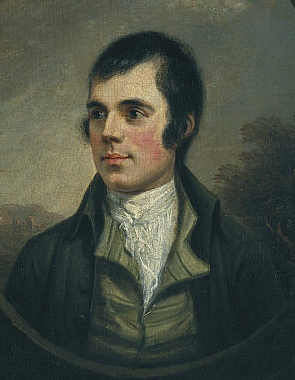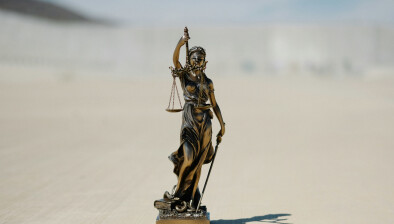David J Black: Robert Burns – America’s lost national bard

Portrait of Burns by Alexander Nasmyth, 1787, Scottish National Portrait Gallery.
Musing over the haggis, coaxed down with a friendly single malt, David J Black shares his thoughts on why it is that so many Scots have a bizarre love-hate relationship with that man from Ayrshire.
Robert Burns is, by a long way, the most celebrated poet in the world. His January 25 birthday feast is marked in almost every country, and his anthem Auld Lang Syne is sung by millions every New Year. There are more than 60 statues and monuments to him worldwide.
A man with a complex and fascinating character, as well as Byronic good looks and a roving eye, he adored, and was adored by, women. One of them (possibly his enthusiastic patroness, the irrepressible Jane, Duchess of Gordon) is said to have stated that “an hour in the dark with Robert Burns is worth a lifetime of light with any other body”. Such references are often apocryphal, yet they are also characteristic of the man and his reputation.
Burns had a boundless capacity for empathy with both mankind and the natural world, and wore his learning lightly. For a ploughman’s son, he was remarkably well educated, having been taught the classics, Latin, French and English literature by a talented graduate, James Murdoch. Politically, he was a radical, though his Jacobite sympathies and Masonic links introduced strains of conservatism. The late 18th century was also a time when too much open debate might invite prosecution under the laws of sedition, particularly if, like Burns, you were cautiously supportive of the American and French Revolutions, and lukewarm on the Hanoverian monarchs.
On the face of it, given all of the above, Robert Burns should be a natural subject for the cinema, yet somehow he’s never quite made the cut. A dramatic exception to the rule was John Cairney, who first played Burns in a 1965 Traverse Theatre solo performance, written by Tom Wright. It was so successful that its run was extended for over two months. John Cairney would go on to specialise in his theatrical depictions of the poet to widespread acclaim. He even entitled his 1987 autobiography The Man who Played Burns.
For film-makers, Robert Burns has always been an elusive quarry, whether in biopic or drama-documentary format – this despite the fact that two of the most renowned documentary makers in the United States, Ken and Ric Burns, are related to him!
The 2004 film Red Rose was the first to attempt a bio-pic of Burns after the quaintly eccentric 1947 Maida Vale bio-epic Comin’ through the Rye, which starred quintessential Englishman Terence Alexander as Burns in his screen debut, though, perhaps mercifully, he had no lines.
Red Rose, a low-budget flop which took unscholarly liberties with known history (suggesting, one hears, that Burns was murdered with the connivance of Edmund Burke!) may have been the catalyst for a 2004 proposal by Gerard Butler, who lined up Julia Stiles, Brian Cox, and John Hannah for a £5 million movie scripted by Alan Sharp. After a decade in pre-production, it fell by the wayside.
Others have suffered a similar fate, including a proposal based on a Danny Boyle script, and another which considered Johnny Depp for the lead role. The actor and director Gerry Mulgrew probably hit the mark when he said “To make a film you need money. There isn’t any money in Scotland so it has to come from somewhere else.”
Burns continues to have a controversial reputation, both morally, politically and in terms of Scotland’s interminable class war. As a son of the soil who endured much hardship, he has great appeal to the left, which customarily regards him as one of its own.
Yet he was always at ease among an upper and middle class literati prone to lionising him, despite which his rousing refrain A Man’s a Man for a’ That is regarded by many as a proto-Socialist anthem. On the other hand, for the 19th century magnate J.P. Morgan, who owned the original manuscript, it was a vindication of the right of an individual to assert his private interests in an age of Manifest Destiny, a view which Donald Trump might well endorse!
Robert Burns has two major black marks against him, it would appear. In 2018, at the height of the #MeToo movement frenzy, former Scottish Makar (poet laureate) Liz Lochhead described a sexual encounter between Burns and his soon-to-be wife, Jean Armour, as “very, very Weinsteinian”. True, he boasted indiscreetly in a March 1788 letter to a close friend, Robert Ainslie, that he had given her a “thundering scalade that electrified the very marrow of her bones”. A bit off-colour, perhaps.
There is, however, a valid plea in mitigation. Burns had attempted to marry Jean some years earlier, but her father had vetoed the union and removed her to another town. In 1788, after the poet had achieved a measure of fame, James Armour had relented. They were formally married in August of that year, though the parish record refers to them having been “irregularly married some years ago”.
Their “thundering scalade” in other words, had effectively been a consensual liason between a husband and wife who loved each other to bits, but for Liz Lochhead his “disgraceful sexual boast – seemed very like a rape of his heavily pregnant girlfriend”. Burns may have been no angel, but to compare such houghmagandie hi-jinks to the sordid crimes of Harvey Weinstein is both palpably absurd and grossly insulting to the latter’s many victims.
Ms Lochhead received support from Burns’ biographer Robert Crawford, who opined that the twenty-something lad o’pairts had “his Weinstein moments” while Jean’s “exclamations of pleasure may well have been cries of pain”. Oh really? Needless to say, such speculation would be instantly dismissed in a present-day court of law, with or without a jury, assuming it ever got past a procurator fiscal, evidence and prejudiced speculation being two very different things.
The other criticism of Robert Burns’ moral character is more difficult to refute, for it was indeed the case that after his enforced separation from Jean Armour, when her father was intent on having him arrested and prosecuted and his debts were mounting, he made up his mind to take passage for Jamaica, where he had been offered a job as a book-keeper on a slave plantation. This was not an unusual conundrum for struggling Scots males at the time, even those of liberal views who, like Burns, were opponents of slavery.
He expressed misgivings about becoming a “poor negro driver” but nonetheless chose to make the journey, hopeful of setting up home there with the new love of his life, Mary Campbell, after his breach with Jean. ‘Highland Mary’ had been a nursemaid in the household of his friend, Gavin Douglas, to whom he confided on his loss of Jean “I feel a miserable blank in my heart, with want of her.” He exchanged matrimonial vows with Mary, who was to join him in Jamaica as expressed in his song, Will ye go to the Indies, my Mary, And leave auld Scotia’s shore?, but she was to die from typhus, aged 23, in 1786, by which time the Kilmarnock edition of his poems had brought him fame, and his emigration plans were abandoned.
Thus did the nascent United States lose a potential national bard. But where’s the proof, do I hear you ask? For a little more light in the darkness part two of this exegesis will produce, if not irrefutable evidence, at least the basis for a sizzling movie pitch.








